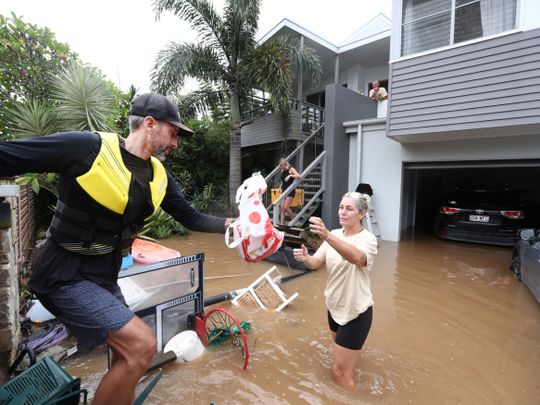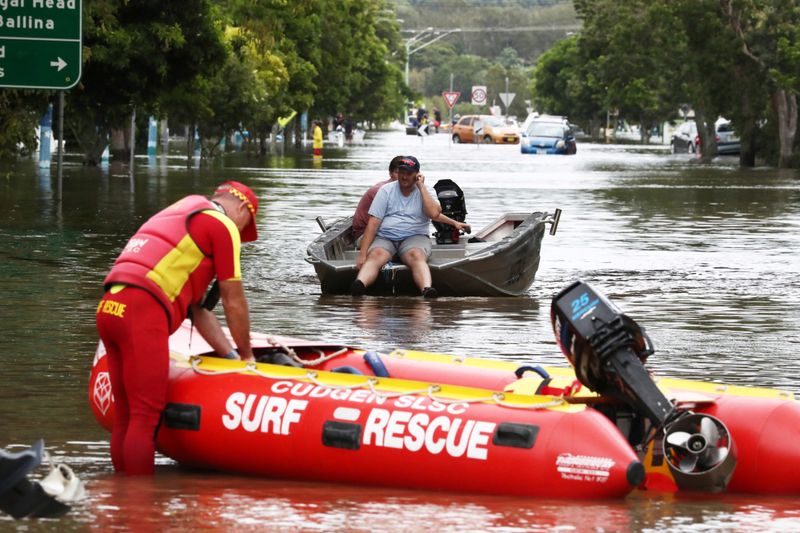
Melbourne: Ten people have died, and thousands have been forced to evacuate their homes in eastern Australia as almost a week of torrential rain and record flooding have submerged houses, washed away construction cranes and smashed boats like toys.
Flash floods had swept through 185 miles of Australia’s coast across two states by Tuesday, with warnings in place for the most populated city, Sydney, as the country endures the final months of the La Nia weather pattern.
Storms began at the Queensland town of Gympie on February 22. They drenched coastal towns on the way to the city of Brisbane, which received 80% of its typical annual rainfall in three days.
The nation has been living under a La Nia weather pattern since November, and it is predicted to ease over the coming months. La Nia ushered in a wetter, cooler summer Down Under. The same pattern, which originates with cyclical changes in the Pacific Ocean, causes a cool, wet winter in the northern United States and a warmer, drier one in the southern part of the country.
In a climate outlook released Tuesday, Australia’s Bureau of Meteorology said climate change continues to affect the country, including through increased rainfall during the wet season between October and April and a “greater proportion of rainfall from high-intensity short-duration rainfall events.”
Kelley Sheenan, editor in chief of the magazine Peppermint, watched social media helplessly at home with her coronavirus-positive son as water encroached on the magazine’s Brisbane office. She rushed to the office alone in the middle of the night to carry computers one by one through ankle-deep water into her car.
“I could feel the water getting higher on my legs each time, so I knew I had to stop as it was getting too scary,” she said.
“From what I can see, the water is almost at the roof, so I don’t think anything will be salvageable,” she said. “It doesn’t seem real.”
As the flooding moved to her home, she said, she was told she shouldn’t to go to an evacuation center because her son had covid and should call hospitals. She instead moved everything to the second story and waited it out, hoping for the best, until water levels receded.

Thunderstorms with large hailstones
In typical Aussie fashion, some residents took advantage of the conditions for unusual sports. A Sunshine Coast bicycle rider was seen tearing through the floodwaters towing a child on a surfboard, and a swimmer was filmed completing a freestyle lap in a drowned football field. Elsewhere, world champion surfer Mick Fanning gave a pharmacist a lift on a Jet Ski between two towns so she could distribute medication.
On Monday, the severe weather hit the city of Lismore in New South Wales, where it turned downtown blocks into swimming pools.
Harrison Eyre, 20, a student, was one of many residents who took to flooded streets in “tinnies” - small aluminum boats - to assist. He said he helped perform about 20 rescues on Monday, including navigating the boat between cabins at a holiday park to reach an older woman waiting on top of a permanent trailer. He climbed onto a roof to save a Dachshund dog and watched helicopters pull people from rooftops using winches, he said.
“At some places, the water was over the top of roofs of double-story houses,” he said. “The State Emergency Service put a call out to all people with boats in the area to do what they could - get in the water and try and find people.”
New South Wales Premier Dominic Perrottet said on Tuesday the disaster was an “unprecedented event” beyond the scale of previous floods.
Dan Clark, 36, a Little League coach, was reeling knowing the Lismore baseball field was under several feet of water after expensive renovations had just been completed. He said he spent Monday “holding my breath and waiting by the phone” for news of friends and family waiting on their roofs.
He has lived in the region, prone to flooding, all his life. He said previous events were “not even close” to the record-breaking water levels he saw on Monday.
The meteorology bureau warned on Tuesday that the same region of Queensland was likely to be hit by severe thunderstorms with large hailstones, damaging winds and more heavy rainfall in the second half of the week. In New South Wales, it predicted, the rainstorm would continue south with flash-flooding possible in Sydney, coastal regions and as far as Victoria - the southernmost state on the east coast.












